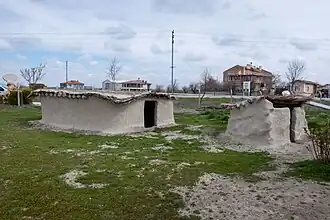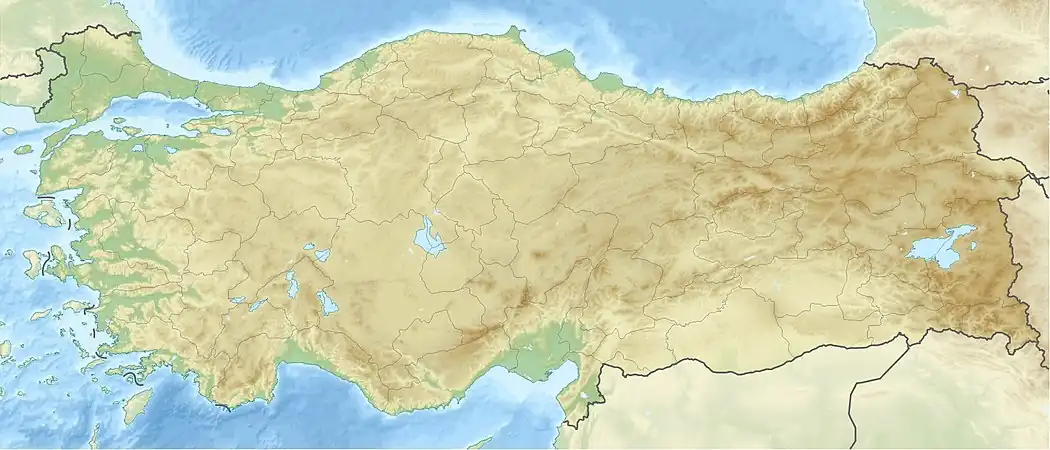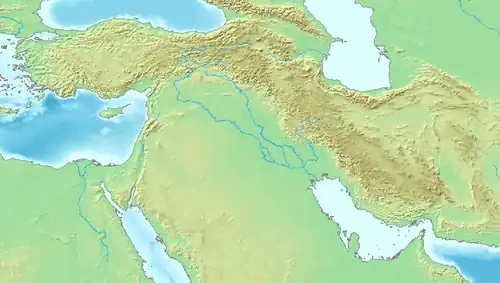Boncuklu Höyük
 Reconstructed Huts at Boncuklu Höyük | |
 Shown within Turkey  Boncuklu Höyük (Near East)  Boncuklu Höyük (West and Central Asia) | |
| Location | Hayıroğlu, Konya Province, Turkey |
|---|---|
| Region | Anatolia |
| Coordinates | 37°45′6.588″N 32°51′53.208″E / 37.75183000°N 32.86478000°E |
| Type | Settlement |
| History | |
| Periods | Neolithic |
Boncuklu Höyük is a Neolithic archaeological site in Central Anatolia, Turkey, situated around 9 km from the more famous Çatalhöyük site. The tell is made up of the remains of one of the world's oldest villages, occupied between around 8300 to 7800 BCE.[1][2] The buildings are small and oval shaped with walls constructed of mudbricks. The remains of burials of human bodies were found below the floors of the buildings. The earliest known ceramics of Anatolia have been discovered there.[2]
The site was first recorded by Douglas Baird of the University of Liverpool in 2001.[1] He has directed excavations there since 2006.[3]
The site of Boncuklu is characterized by some of the first appearance of agriculture in the Anatolian plateau, through the introduction of small-scale agricultural projects. It is considered as a precussor of the large-scale agricultural developments of Çatalhöyük from 7100 BCE.[4]
See also
References
- ^ a b "The Site". Boncuklu Site. 2013-06-07. Retrieved 2021-08-19.
- ^ a b Spataro, M.; Fletcher, A.; Cartwright, C.R.; Baird, D. (2017-12-01). "Boncuklu Höyük: The earliest ceramics on the Anatolian plateau". Journal of Archaeological Science: Reports. 16: 420–429. doi:10.1016/j.jasrep.2016.10.011. ISSN 2352-409X.
- ^ "Project Aims". Boncuklu Site. 2013-06-07. Retrieved 2021-08-19.
- ^ Baird, Douglas; Fairbairn, Andrew; Jenkins, Emma; Martin, Louise; Middleton, Caroline; Pearson, Jessica; Asouti, Eleni; Edwards, Yvonne; Kabukcu, Ceren; Mustafaoğlu, Gökhan; Russell, Nerissa; Bar-Yosef, Ofer; Jacobsen, Geraldine; Wu, Xiaohong; Baker, Ambroise; Elliott, Sarah (3 April 2018). Agricultural origins on the Anatolian plateau. pp. E3077 – E3086.
Furthermore, rather than being a short-lived transitional state, low-level food production formed part of a subsistence strategy that lasted for several centuries, although its adoption had significant long-term social consequences for the adopting community at Boncuklu. Material continuities suggest that Boncuklu's community was ancestral to that seen at the much larger settlement of Çatalhöyük East from 7100 cal BC, by which time a modest involvement with food production had been transformed into a major commitment to mixed farming, allowing the sustenance of a very large sedentary community.